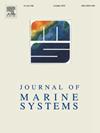群落生态分类与制图的分层方法:在黑海东北部大型底栖动物中的应用
IF 2.5
3区 地球科学
Q2 GEOSCIENCES, MULTIDISCIPLINARY
引用次数: 0
摘要
近年来,全球气候变化和环境污染导致了大型底栖动物群落的变化。现有的定义和映射社区的方法非常多样化。因此,对时间变化和空间变异性的评估在很大程度上取决于所采用的方法。本文提出了大型底栖动物群落的三层次(生态复合体、生物群落、亚群落)分类方法。生态复合体是一个物种池,具有明确的主导因子范围。该池在特定的生物群落中形成了相应的生物群落;它们具有独特的物种组成和特定的结构,是生物相互作用和生境特性共同作用的结果。不同亚属具有相似的种组成和部分相似的数量结构;一种生物群落的亚群落所居住的生物群落之间的差异很小或在实践中无法检测到。该方法增强了不同方法得到的数据集的组合和比较。本文以黑海东北部陆架和陆坡的大型软底动物为例。在研究区内确定了两个生态复合体。它们由主要水团的温度和盐度状况来区分;它们的边界与季节性温跃层的最深处重合。在这些复合体中描述了3个生物群落和8个亚群落。生态复合体内生物群落和亚群落的分化主要受沉积物类型和氧状态的驱动。拟议的方法被用来在黑海东北部大陆架的欧洲生态系统生境制图中指定第5级基准。在生态学研究中,community和biocoenosis可以被不同的作者用作同义词或具有不同含义的术语。许多作者将黑海和亚速海的底栖动物划分为生物群落(Vorobyov, 1949)、群落(Sezgin et al., 2010)或混合概念(chinina和Kucheruk, 2005)。在目前的工作中,这些术语被用作同义词,根据(Sukachev, 1949)表示生物地球污染的生物成分。本文章由计算机程序翻译,如有差异,请以英文原文为准。
Hierarchical approach to communities' ecological classification and mapping: Application to northeastern Black sea macrozoobenthos
Recently, global climate change and environmental pollution led to changes in macrozoobenthic communities. Existing approaches to defining and mapping communities are extremely diverse. Consequently, assessment of both temporal changes and spatial variability depends greatly on the approach used. This paper proposes a three-level (ecological complex, biocenosis, subcenosis) hierarchical approach to classification of macrozoobenthos communities. Ecological complex is a species pool typical of a well-defined range of leading factors. Corresponding biocenoses are formed in specific biotopes from this pool; they have a characteristic species composition and a specific structure which result from joint actions of both biotic interactions and the habitat properties. Different subcenoses have a similar species composition and partially resembling quantitative structure; differences between biotopes inhabited by subcenoses of one biocenosis are minor or undetectable in practice. Proposed approach enhances combining and comparing datasets obtained by different methods. The paper focuses at the example of soft-bottom macrozoobenthos in the northeastern Black Sea shelf and slope. Two ecological complexes are identified in the study area. They are distinguished by temperature and salinity regimes in main water masses; their boundary coincides with the deepest position of the seasonal thermocline. Three biocenoses and eight subcenoses are described within these complexes. The differentiation of biocenoses and subcenoses within the ecological complexes is driven primarily by the sediment type and oxygen regime. The proposed approach is used to designate a base of level 5 in the EUNIS habitat mapping for the northeastern Black Sea shelf.
Glossary
Community and biocoenosis in ecological studies can be used by various authors as synonyms or as terms with different meanings. Various authors described benthic fauna divisions of the Black Sea and Sea of Azov as biocenoses (Vorobyov, 1949), communities (Sezgin et al., 2010), or mixing the concepts (Chikina and Kucheruk, 2005). In the present work, these terms are adopted as synonyms, denoting the biological component of biogeocenosis according to (Sukachev, 1949).
求助全文
通过发布文献求助,成功后即可免费获取论文全文。
去求助
来源期刊

Journal of Marine Systems
地学-地球科学综合
CiteScore
6.20
自引率
3.60%
发文量
81
审稿时长
6 months
期刊介绍:
The Journal of Marine Systems provides a medium for interdisciplinary exchange between physical, chemical and biological oceanographers and marine geologists. The journal welcomes original research papers and review articles. Preference will be given to interdisciplinary approaches to marine systems.
 求助内容:
求助内容: 应助结果提醒方式:
应助结果提醒方式:


